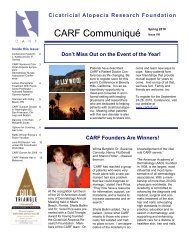Folliculitis decalvans - Cicatricial Alopecia Research Foundation
Folliculitis decalvans - Cicatricial Alopecia Research Foundation
Folliculitis decalvans - Cicatricial Alopecia Research Foundation
You also want an ePaper? Increase the reach of your titles
YUMPU automatically turns print PDFs into web optimized ePapers that Google loves.
Otberg et al.<br />
FIG. 3. (a) Thirty-two-year-old male patient with folliculitis<br />
<strong>decalvans</strong> and acne keloidalis, (b) keloid-like lesion in the<br />
neck, and (c) follicular tufting and follicular hyperkeratosis<br />
in the vertex area.<br />
onset; first noticeable symptoms, such as pain,<br />
itching, or burning sensations; first clinical presentation,<br />
such as pustules, bleeding, and crusts;<br />
and disease progression. Furthermore, it is important<br />
to know if the patient has a history of recur-<br />
rent<br />
240<br />
S. aureus<br />
or other bacterial infections, if<br />
relatives are suffering from similar symptoms,<br />
and if the patient can recall an injury prior to<br />
developing the scalp lesions. Patients’ reports<br />
FIG. 4. Thirty-nine-year-old female patient displaying lesions<br />
of folliculitis <strong>decalvans</strong> with follicular tufting and diffuse and<br />
perifollicular erythema.<br />
about members of the same household with similar<br />
scalp symptoms or other skin lesion and pets with<br />
fur problems lead more to the tentative diagnosis<br />
of an infectious cause of the scalp problem,<br />
particularly deep fungal infections with zoophilic<br />
dermatophytes.<br />
The next step is a thorough examination of the<br />
entire scalp. Diagnostic tools, such as a 3-fold<br />
magnifying lens, a 10-fold magnifying dermatoscope,<br />
or a 60- to 200-fold magnifying Folliscope®<br />
(Lead M, Seoul, Korea) with and without polarized<br />
light, can help to identify the presence or absence<br />
of follicular ostia, perifollicular erythema, and follicular<br />
hyperkeratosis in the affected areas.<br />
A sketch and measurements of the scarred<br />
areas are helpful to monitor disease progression.<br />
Baseline scalp photography should be carried out,<br />
ideally with a ruler, on the first visit (FIG. 4).<br />
Bacterial cultures should be taken from an<br />
intact pustule (18) or from a scalp swab. Additionally,<br />
a nasal swab should be performed to identify<br />
an occult S. aureus reservoir. Testing of antibiotic<br />
sensitivities is recommended. A skin biopsy of an<br />
active lesion is crucial for the diagnosis of FD. It is<br />
mandatory in the diagnosis of every scarring<br />
alopecia. Guidelines for scalp biopsies have been<br />
worked out by a consensus meeting at Duke University<br />
in February 2001: One 4-mm punch biopsy<br />
including subcutaneous tissue should be taken<br />
from a clinically active area, processed for horizontal<br />
sections, and stained with hematoxylin and<br />
eosin (35). The biopsy should be taken from an<br />
active hair-baring margin of the lesion and has to<br />
follow the direction of the hair growth.<br />
Periodic acid–Schiff stain helps to identify fungi<br />
and together with mucin stains can help to identify<br />
discoid lupus erythematosus. Elastin stain (acid



